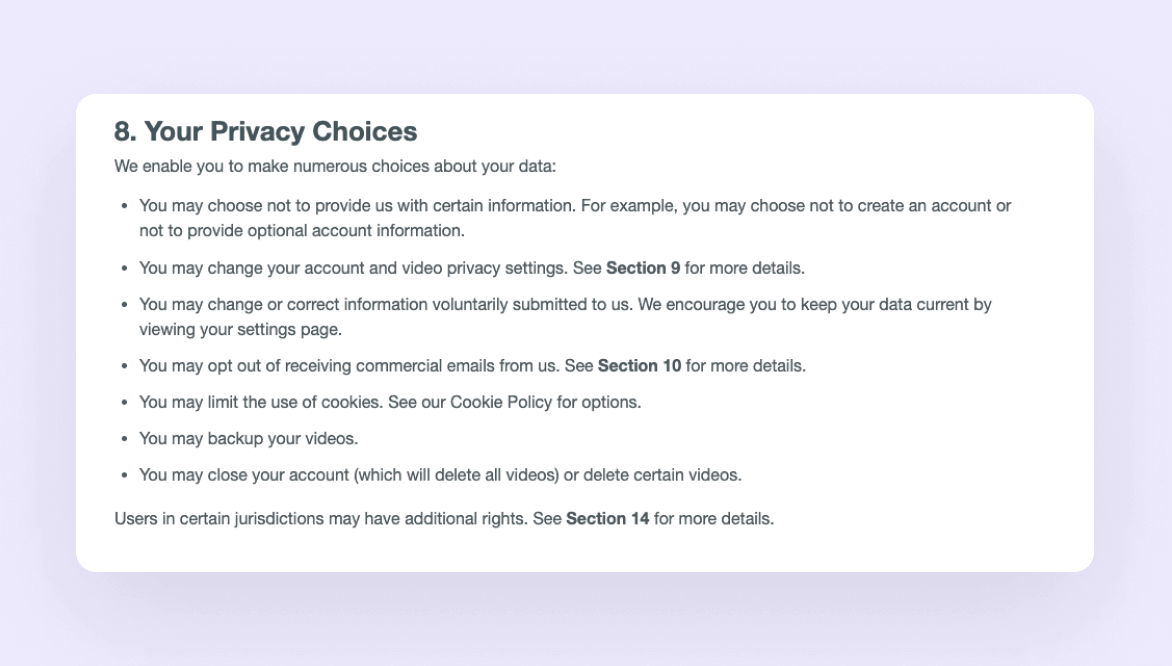5 tips on turning your privacy policy into a marketing asset


All privacy policies have a legal purpose, but some are so much better than others. Why, you ask? What makes one brand’s privacy policy more effective?
A good privacy policy is one of the most essential tools to gain and increase user trust and customer loyalty. Even though the privacy policy is a legal document at its core, you should look at it as another marketing asset. As such, it should be accessible, respectful, straightforward, transparent, and speak the language of its target audience - your users and potential customers.
Privacy policies should help users understand how their personal data is being used and provide them with a suitable choice to control it. To help you do this we’ve collected our <hl>top five tips and examples<hl> on creating a user-friendly privacy policy.
1. Keep it relevant, meaningful, and to the point.
Your privacy policy needs to highlight information about your business that is relevant to your users and customers. It’s best to avoid generalizing and catch-all phrases - take advantage of this opportunity to clarify any confusion before it arises.
Follow these guidelines for a clear policy:
- Describe how and why you collect personal information, what you intend to do with that information, and under what circumstances you might share that information.
- If you disclose personal information to third parties, explain who those parties are or what services they provide.
- Share the automatic data collection tools you’re using (cookies and other tracking technologies), but don’t stop there. You should also describe how the information users submit will be used and/or disclosed.
You can see that this is the main thing we kept in mind when we created our privacy policy.
The highlights tab covers the most meaningful and relevant information users need to know when it comes to their privacy online.

2. Distinguish yourself from the rest.
Your privacy policy reflects directly on your brand. You need to make sure that it serves your company and customers. Hence, your policy should reflect the unique culture of your own organization. Follow these points to create a policy that speaks your brand’s language:
- Avoid templates and online example policies.
- Create a policy that follows your brand guidelines (i.e., design, format, colors).
- Use the same tone of voice as in the rest of your website.
Webflow’s privacy policy won us over with their side panel boxes addition, which includes a down-to-earth explanation for every section in the policy.

3. Use plain language, so not only lawyers can understand it.
Avoid legal terms and explain your practices in a language that any visitor to your site will understand. Go the extra mile and provide summaries or explanations of complex topics, as well as links and references to the full description.
Ensure that the document is as brief as possible while providing the details that people must know. We recommend structuring your policy for ease of reference and making it user-friendly.
Look at the way Apple’s privacy page was structured and how this contributes to its readability.

4. Remember, the choice is always theirs.
Transparency and choice are the core of our data privacy ideology.
You should inform customers about their available options regarding collecting, using, or disclosing their information (e.g., choosing not to share personal data for marketing purposes) and clearly explain how they can exercise those choices.
Explain how they can obtain access to their personal information, request a correction, or the complete deletion of their data. Provide further details through the use of links or pop-up windows whenever a user might need to make a privacy choice.
Lastly, make privacy information easy to find by placing the link in a prominent location on your homepage.
Draw inspiration from Vimeo’s privacy policy when explaining choice and access to your users:

5. Update regularly and make an effort to get feedback.
Consistently review your privacy policy, ensuring it reflects current practices at the company (especially when new ways of handling information are introduced).
Actively inform users and customers when the policy is changed, and always include a timestamp of when the last review/update occurred.
Make it easy to reach out to you by sharing details of privacy-specific contacts (e.g., Data Privacy Officers, Data Protection Officer), enabling them to effortlessly raise privacy questions, complaints, or requests.
A great example can be found on Monday.com’s privacy page.
It begins with a personal note from their Data Privacy Officer and includes an email address to give feedback.

To sum up, your privacy policy can impact your brand in more ways than one. Take note to make it extraordinary, stand out from the competition, and win over your users or potential customers. You never know; you just might find yourself showcased in a blog post about note-worthy privacy policy writing tips ;)
You’re welcome to head over to our privacy policy to see how we implemented these tips.